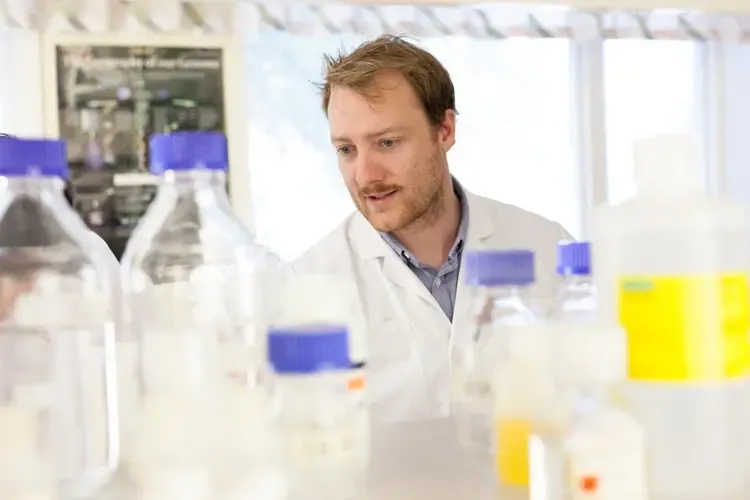
Division of Eye and Vision
The Division of Eye and vision which is located at St. Erik Eye Hospital, conducts education at the undergraduate, advanced and postgraduate levels, as well as research with the aim of developing the eye care of the future.
Menu for this area
 Photo: Foto: Unsplash
Photo: Foto: UnsplashPopular weight-loss drugs linked to rare but serious eye conditions
GLP-1 agonists such as Ozempic have changed the way clinicians manage diabetes and obesity around the world. Two new studies suggest that people taking these drugs have a small increased risk of serious eye conditions and vision loss.
Read the news article in The Conversation, written by Flora Hui and Pete Williams.
 Photo: Pixabay,Mohamed Hassan
Photo: Pixabay,Mohamed HassanPete Williams awarded grant from the Swedish Brain Foundation
Each year, the Swedish Brain Foundation supports qualified research on the brain and other nervous systems, as well as diseases, injuries, and disabilities throughout the nervous system.
Pete Williams, researcher at Karolinska Institutet and St. Erik Eye Hospital, has been awarded a research grant from the Swedish Brain Foundation for his project: "NAD metabolism as a target for neuroprotection in age-related ophthalmic and neurodegenerative diseases".
The grant, which amounts to SEK 2.4 million, will fund the research over a three-year period.
 Photo: Flora Hui
Photo: Flora HuiGlaucoma researcher Pete Williams receives grant from American foundation
Pete Williams, researcher at Karolinska Institutet and St. Erik Eye Hospital, has been awarded a research grant from the American Glaucoma Foundation to develop a treatment for glaucoma and other eye diseases. With the grant of USD 75,000 (SEK 840,000), the Foundation wants to recognize groundbreaking, innovative glaucoma research. This is the second time Pete Williams has received the grant.
Metabolic analysis of sarcopenic muscle identifies positive modulators of longevity and healthspan in C. elegans
Sarcopenia is the age-related degeneration of skeletal muscle, resulting in loss of skeletal muscle tone, mass, and quality. Skeletal muscle is a source of systemic metabolites and macromolecules important for neuronal health, function, and healthy neuronal aging. Age-related loss of skeletal muscle might result in decreased metabolite and macromolecule availability, resulting in reduced neuronal function or increased susceptibility to unhealthy aging and neurodegenerative diseases.
Ganglion Cell Complex Thickness and Visual Function in Chronic Leber Hereditary Optic Neuropathy
In this cross-sectional study, we assessed the thickness of the macular ganglion cell complex using semi-automated segmentation and explored its correlation with visual function in individuals with chronic Leber Hereditary Optic Neuropathy (LHON), recruited from the Swedish LHON registry. Our goal was to better understand the relationship between structural and functional aspects of the visual system in this clinical population.
More articles
Visual Neuroscience – Rune Brautaset's research group
Ganglion Cell Complex Thickness and Visual Function in Chronic Leber Hereditary Optic Neuropathy
In this cross-sectional study, we assessed the thickness of the macular ganglion cell complex using semi-automated segmentation and explored its correlation with visual function in individuals with chronic Leber Hereditary Optic Neuropathy (LHON), recruited from the Swedish LHON registry. Our goal was to better understand the relationship between structural and functional aspects of the visual system in this clinical population.

Generous donation to eye research at KI
The Ulla and Ingemar Dahlberg Foundation has decided to donate SEK 50 million to Karolinska Institutet. The grant will be used for a new professorship in vision science with a focus on ocular neurobiology and have the full name "Ulla och Ingemar Dahlbergs professur i synvetenskap med inriktning mot okulär neurobiologi" (Ulla and Ingemar Dahlberg's Professorship in Visual Science with specialization in Ocular Neurobiology).
"It's an incredibly important and welcome donation. KI generally has a relatively small number of professors in ophthalmology, so this addition will make a big difference to eye research in Sweden," says Rune Brautaset, professor at the Department of Clinical Neuroscience and head of the Division of Eye and Vision.

He looks at brain disorders through the retina
With the help of OCT analysis, there is a simple and inexpensive way of examining the eyes in order to monitor the progression of disease and effect of treatment in people with multiple sclerosis (MS).
We can do this since loss of nervous tissue in the brain is reflected in the retina, says Optometrist and researcher Rune Brautaset who uses OCT for his research.
Physiological optics
More publications
Retina – Anders Kvanta's research group
 Photo: Getty Images,Getty Images/iStockphoto
Photo: Getty Images,Getty Images/iStockphotoGene therapy effective in hereditary blindness
Bothnia dystrophy is a form of hereditary blindness, prevalent in the region Västerbotten in Sweden. A new study at Karolinska Institutet published in Nature Communications shows that gene therapy can improve vision in patients with the disease.
 Photo: Stefan Zimermann och Ulf Sirborn
Photo: Stefan Zimermann och Ulf SirbornKI researchers Anders Kvanta and Fredrik Lanner awarded a SEK 10 million grant
The Erling-Persson Foundation has awarded Anders Kvanta, professor at the Department of Clinical Neuroscience, Karolinska Institutet, and Fredrik Lanner, senior researcher at the Department of Clinical Science, Intervention and Technology, Karolinska Institutet, a research grant of SEK 10 million extending over three years.
Retina
Ocular Oncology and Pathology – Gustav Stålhammar's research group
 Photo: Jens Sølvberg
Photo: Jens SølvbergGustav Stålhammar, nominated as one of the emerging and promising young researchers from the Nordic countries.
Acta Board have been nominated Gustav Stålhammar as one of the emerging and promising young researchers from the Nordic countries.
followed by a session with four young speakers from the Scandinavian countries, each of whom will talk about their own research. We invite you to be one of these speakers.
On the occasion of the 100th of Acta anniversary in Maastricht in June, Gustav is invited together with Joni Turunen, Finland och Cecilie Bredrup, Norway to speak about their own research.
Title of Gustavs lecture is: ”Uveal melanoma past, present, and future -Towards adjuvant treatment”
 Photo: Karin Lundin
Photo: Karin LundinOverrepresentation of human epidermal growth factor receptor 2 positive- and Luminal B breast cancer metastases in the eyes and orbit
Vi visar att 4 av 5 bröstcancermetastaser i ögonen och orbita är av typen Luminal B, och att fler än hälften är positiva för HER2.
Vidare ser vi även att subtypen av bröstcancer ofta ändras mellan primärtumören i bröstet och metastasen i ögat.
Ocular Oncology and Pathology
Increasing Incidence of Posterior Uveal Melanoma in Scandinavia 1960–2022: A Tri-National Study
The incidence of posterior uveal melanoma in Scandinavia has increased over the past six decades, with a linear trend that is independent of changes in tumor size or patient age at diagnosis. A deeper understanding of the underlying risk factors and evolving diagnostic practices is essential to inform public health initiatives, enhance early detection, distinguish melanomas from benign counterparts, and optimize management strategies for uveal melanoma.
Nationwide analysis of sex differences in waiting times for cataract surgery in Sweden between 2010 and 2022
We observe a persistent, albeit small, difference in waiting times favoring males. These findings highlight a systemic disparity that warrants further investigation and targeted interventions to ensure equitable access to cataract care.
Ocular Oncology and Pathology
Eye movements and vision – Tony Pansell's research group
 Photo: Johanna Hanno
Photo: Johanna HannoA novel view on the role of vision in brain injury
Each year tens of thousands of Swedes suffer from concussion. Some of them experience persistent difficulties, such as brain fatigue, sensitivity to light, headache and problems focusing. Optometrist and Research Group Leader Tony Pansell researches the benefits of spectacle treatment and vision therapy in this context.
Vision impairment is common in non-hospitalised patients with post-COVID-19 syndrome
Vision-related symptoms and impairments were prevalent in the study group. The Developmental Eye Movement Test and the Visual Motion Sensitivity Clinical Test Protocol showed promise for clinical assessment of saccadic performance and sensitivity to movement in the environment. Further study will be required to explore the utility of these tools.
Eye movements and vision
Glaucoma – Pete Williams' research group
 Photo: Pixabay,Mohamed Hassan
Photo: Pixabay,Mohamed HassanPete Williams awarded grant from the Swedish Brain Foundation
Each year, the Swedish Brain Foundation supports qualified research on the brain and other nervous systems, as well as diseases, injuries, and disabilities throughout the nervous system.
Pete Williams, researcher at Karolinska Institutet and St. Erik Eye Hospital, has been awarded a research grant from the Swedish Brain Foundation for his project: "NAD metabolism as a target for neuroprotection in age-related ophthalmic and neurodegenerative diseases".
The grant, which amounts to SEK 2.4 million, will fund the research over a three-year period.
Glaucoma
Short-term high-dose nicotinamide treatment across glaucoma subtypes reveals increased mtDNA content and minimal metabolomic change in blood
Glaucoma is the leading cause of irreversible blindness in the world, estimated to affect more than 70 million people. In recent years, mitochondria and the RGCs’ bioenergetic risk have emerged as promising targets. Mitochondria are the key cell energy organelles, producing ATP through a group of protein complexes (oxidative phosphorylation; OXPHOS). Mitochondria have been proposed as a disease component and neuroprotective target in many neurodegenerative diseases
Interventional Vitamin Mix Glaucoma Study (IVMGS): study protocol for a prospective, randomized, two-arm, single-center trial in existing glaucoma patients
Glaucoma is a leading cause of irreversible blindness, characterized by progressive degeneration of retinal ganglion cells. Current treatments primarily lower intraocular pressure but do not directly provide neuroprotection. Preclinical studies from our group have identified dysfunction in one-carbon metabolism as a contributor to glaucomatous neurodegeneration in rodent models. The Interventional Vitamin Mix Glaucoma Study will evaluate whether 12 months of supplementation with key one-carbon metabolism cofactors and precursors (vitamins B6, B9, B12, and choline) can improve inner retinal function and provide neuroprotection compared with standard care alone.
Metabolic analysis of sarcopenic muscle identifies positive modulators of longevity and healthspan in C. elegans
Sarcopenia is the age-related degeneration of skeletal muscle, resulting in loss of skeletal muscle tone, mass, and quality. Skeletal muscle is a source of systemic metabolites and macromolecules important for neuronal health, function, and healthy neuronal aging. Age-related loss of skeletal muscle might result in decreased metabolite and macromolecule availability, resulting in reduced neuronal function or increased susceptibility to unhealthy aging and neurodegenerative diseases.
Glaucoma
More publications
